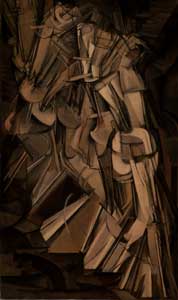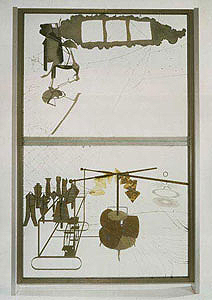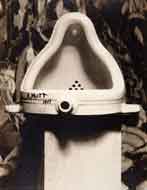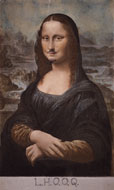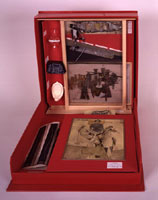|
GUY VIAU. Marcel Duchamp, what power do you attribute to humor? MARCEL DUCHAMP. A great power; humor was a sort of savior so to speak because, before, art was such a serious thing, so pontifical that I was very happy when I discovered that I could introduce humor into it. And that was truly a period of discovery. The discovery of humor was a liberation. And not humor in the sense "humorist" of humor, but "humor" humoristic of humor. Humor is something much more profound and more serious and more difficult to define. It's not only about laughing. There's a humor that is black humor which doesn't inspire laughter and which doesn't please at all. Which is a thing in itself, which is a new feeling so to speak, which follows from all sorts of things that we can't analyze with words. G. Is there a large amount of rebellion in this humor? M. A large amount of rebellion, a large amount of derision toward the serious word, entirely unconfirmed, naturally. And it's only because of humor that you can leave, that you can free yourself. G. When is humor black? M. Black, that's a way of speaking, since it was necessary to assign a color. Obviously there wasn't a more explicit color because black is somber, the somber of this humor makes it a thing almost mean instead of friendly and dangerous. It's almost like a sort of dynamite, of the spirit, isn't it? And that's why we call it black. Black doesn't have any meaning but it's a little like the black curtain of anarchy, if you will, things like that. Black generally took this somber side and burial that we were obligated to accept, then that was it. G. You've said somewhere that possible reality is obtained from a little stretching of the laws of physics and chemistry. What do you want to say about that? M. About that, it's simply the idea that it's easy to believe that by scraping a match one gets a fire, that is, cause creates effect. But I find the laws of physics such that they are, such that they have taught us, aren't inevitably the truth. We believe in them or the experiences each day, but I believe that it's possible to consider the existence of a universe where these laws would be extended, changed a little bit, precisely limited. And as a result, one immediately obtains some extraordinary and different results which are certainly not far from the truth because, after all, every hundred years a new scientist comes along who changes the laws, right? Since Newton, there have been more and since Einstein there have been even more, haven't there, so we must wait for changes to the laws in question. G. But all your activity, I think, aims at the possible beyond the immediate. M. Sure. In every case, without being a scientist myself, one can hope to arrive at obtaining some results parallel to the influence, if you will, in art. And what gives satisfying results in every case… satisfying in the sense of the new of the thing, what appears like a thing which was never seen before. Of the not already seen. G. This said, Marcel Duchamp, you weren't less of an impressionist at the start of your career than anyone else. M. Yes, absolutely, like all youth. A young man can't be an old man, it's impossible. One must pass through the network of influence. One is obligated to be influenced and one accepts this influence very naturally. From the start one doesn't realize this. The first thing to know: one doesn't realize one is influenced. One thinks he is already liberated and one is far from it! Therefore one must accept it and wait for the liberation to come itself, if it must ever come, because certain people never obtain it, never see it come. G. But it's been said that you made these impressionistic experiences a little to prove that you could make them. M. No, no… G. … like a tour de force. M. No, I don't believe that this was so. If you wish, when one paints like an impressionist from the age of seventeen or sixteen, one is already so content to paint, since one loves this, that there isn't analysis, self-analyzation that explains why one makes this rather than that and above all one never knows these things until forty years later. G. And what was the Section d'Or back then? M. The Section d'Or dates from 1912. It was a small salon which took place for only a year, where all the cubists of that era got together, except Picasso and Braque, who stayed in their corner. There was, already, a sort of schism between the two groups of cubists. And there we made, thanks to my brother Jacques Villon, and Picabia … quite an exposition of paintings, with Apollinaire, that had a lot of success. Apollinaire, I believe, created a meeting place for presenting young painters who, at that time, were iconoclasts, as well you'd think. G. And this cubism, did it not contain, if I may say … a little futurism?
M. Yes, there was a relationship in everything. The time was made for this. With the futurists there was something a little different, which was the preoccupation of producing a movement, of producing the movement. To try, if one produces the movement, to produce it from an impressionistic manner, which is to say naturalist, to give the illusion of movement, this was the mistake in itself, since one can't produce a thing, one can't produce a movement--in any realistic manner--from a static tableau, you see? It's not possible. Why did it fail, because it was the continuation of the impressionist idea attributed to the movement, given to the movement. Whereas, for example, in my case, where I wanted to make the same thing with Nude Descending the Staircase, (Fig. 1) it was a little different. I realized very well that I couldn't produce the illusion of movement in a static painting. I was therefore content to make a state of thing, a state of movement, if you will, like the cinema does, but without the development of the cinema like a film. To superimpose one upon the other. G. Each of these phases? M. Each of these phases … indicated a completely graphic way and not the intention of giving the illusion of movement. G. And it's this that made Nude Descending the Staircase a sensation at the Armory Show in 1913. M. That was it. G. … in New York. M. And this was a sort of scandalous success which was so much so, that a lot of people knew Nude Descending the Staircase itself and they never knew who had made it. And this absolutely didn't interest them--knowing who was the painter. Because the painting was interesting them in the painting and this was the only thing which was interesting to them, so that I was completely … how should I say … G. … ignored. M. … ignored by the public because the public knew my work without knowing who I was or that I existed. G. Was it from this moment that you renounced more or less the traditional notion of a painting? M. Yes, it was around 1913, around 1912, and it was 1913 when I even began to doubt my cubism. I began to… I was probably very difficult to satisfy then, I suppose… And when I had already thought that that was the end, that this wasn't going to lead very far, except that it would have been able to make a lot of money perhaps if I had continued. But then, I had already changed ideas in 1913, and I found myself engaged in another form of expression where the painter loses his priority, if you will. The idea for me was, at that time, to bring in gray matter in opposition to the retinal. For me the retinal is a thing that has lasted since Courbet. After Romanticism, with Courbet, every series for a hundred years of painting or plastic art was based on the retinal impression. G. For you, it has been a hundred years since painting wasn't so uniquely retinal. M. No, not at all, far from it, on the contrary. Everything which represents religious painting, painting since the Renaissance, through the Italian Renaissance, is entirely gray matter, if I dare to use this term when I mean that that the idea was to glorify a religion, the catholic religion, the catholic God or something else, in the end, but the painting aspect itself, the retinal aspect of the painting was very secondary … more than secondary … it was the idea that mattered then. And this is what happened, this is what happened to me then in 1912 or 1913 with the idea of wanting to change or at least to rid myself of the retinal heritage of the last 100 years. G. You said at that time, "Paintings have the dust of the past." M. What made me say things like that was because it was necessary to get rid of and to obtain another opening onto other landscapes, so to speak. G. Was it then, Marcel Duchamp, that Dada took place?
M. No, that was still in the distance. That was still later. I spoke of 1912 and in 1912 I had already elaborated upon the idea of The Bride Stripped Bare by Her Bach…by Her Bachelors, still without a hint of Dadaism. There was obviously a germ of things resembling Dadaism, but it didn't have the organized character of a movement like the Dadaism of 1916, 1917 and 1918. There had already been indications of such a movement, and even in The Bride Stripped Bare by Her Bachelors, Even there are some details or developments which are of the Dadaist domain. But all the same, that was something a lot larger in spirit than a tendentious thing like Dadaism was … After all, Dadaism was a tendency to get rid of a violent way of accepted and permitted things. But then it was still a personal thing which alone concerned me, of making a picture or some kind of work with my responsibility alone and not a manifesto of the general order. Later, around 1916, 1917 in fact, Dadaism intervened and I collaborated there because it immediately went along with my views. G. All right, if you want, we will revisit Dadaism now. I would very much like you to speak to us more about The Bride Stripped Bare by Her Bachelors, Even. (Fig. 2) What is the key to this painting? I believe I read from André Breton that there was a son of Ariane in the painting? M. There isn't a son of Ariane. There is the fact that from the start this painting wasn't conceived like a canvas on which you put a picture. The painting is like a morsel of glass. From the start, it was painted on glass, which is in effect painted upon. Some oil paint is painted, but the forms which are there were from the start were seen with the idea of transparence. The idea of canvas disappeared. In order to still satisfy me, to satisfy me with the idea that the painting isn't a painting, which is to say a frame with some canvas on top and some nails around. I wanted to rid myself of that, which is a physical impression. After this, each part of the painting, of the glass, was minutely prepared with ideas and not with the strokes of a pencil. From ideas written on little papers as they came to me. And finally some years after I gathered in a box called the Green Box all these ideas, these little papers… cut up or torn up, rather, which I made torn up in order to make an edition of 300 exemplary copies and which are in the same form as the cut, original papers and on which nearly all the ideas that are in this big glass are written, or indicated in any case. G. Who were the principal protagonists of Dada then? M. The first demonstrations of Dada took place in Zurich in 1916, with Tzara and Arp and Huelsenbeck and that was about it. And this lasted two or three years. After that Tzara went to Paris, where he made the acquaintance of Breton, Aragon…several others who became the Dada of Paris. The difference is that, in Zurich, there wasn't really a big public demonstration, which is to say there was a Cabaret Voltaire with some demonstrations but more or less private, in the cabaret. In Paris, it reached a much larger scale and Breton and Aragon made some demonstrations in rooms like la salle Gaveau, where the public really went, en masse, with the idea of very copiously causing an uproar, you might say. And moreover, this is what made all the fuss about Dada. For three years there had been different demonstrations in each of the big rooms of Paris, and this was only terminated around 1920, 1922 or 1923, when truly there was some internal dissentions between the different dadaists, who were no longer content. With each wanting to be the big protagonist, naturally there were some disagreements. They had a falling out and Breton decided to begin another thing called Surrealism. What's more, the name Surrealism had been given by Apollinaire during the war without knowing it, to a piece called les Mamelles de Tirésias, in a small Parisian theater and it was called, I believe, Surrealist Drama. But in any case the word "Surrealism" was…fabricated by Apollinaire and he didn't know that it was going to take on such importance, I am sure of that, when I think about it. G. And your friendship with Picabia dates back to then?M. Oh yes! Picabia naturally was one of the big ones, was, so to speak, the go-between, he was different because he was in New York and we had already known Dada in 1916 in New York when he was here and then he left New York in 1917-18, he went to Barcelona. From there he went to Switzerland. He went to Switzerland where he made the acquaintance of Tzara. Tzara and he went back to Paris, made friends with Breton and really the movement began then. Besides, this is what wasn't approved by the German Dadaists, who wanted to make it a completely political thing, a political order only, in the communist sense of the word. G. You spoke of Dada demonstrations. What were these demonstrations? Were they about manifestos, or what? M. No. They were theatrical demonstrations. And yet! There was a scene, for example in la salle Gaveau which wasn't a scene, but anyway it was a scene just the same where the orchestra sat to play concerts. There were theatrical pieces created for the occasion by Breton, by Ribemont-Dessaignes, by people like that, which were played with the appropriate décor, which is to say, with cotton caps, funnels, everything was like a fantasy…imaginative. G. Marcel Duchamp, what is a ready-made? M. A ready-made [laughs], was from the beginning an invented word that I took to designate a work of art which isn't one. In other words, which isn't a work made by hand. Made by the hand of the artist. It's a work of art which becomes a work of art by the fact that I declare it or that the artist declares it a work of art, without there being any participation from the hand of the artist in question to make it so. In other words, it's an object already made, that one finds, and generally an object of metal…more than a painting in general. G. Would you want to give an example of a ready-made in its pure state?
M. We have…the urinal, that I exhibited at the Indépendants in 1917 in New York and which was a thing that I had simply bought at the M. Mutt Works, and that I signed Richard Mutt. (Fig. 3) And which was moreover refused by the Independents, who weren't supposed to refuse it. But anyway, they refused it, they threw it behind a partition and I was obligated to find it after the exhibition in order not to lose it. G. But there is what you call an "assisted" ready-made. M. Okay, with the "assisted ready-made," it's just an object in the same genre to which the artist adds something like a moustache to the Mona Lisa, (Fig. 4) which is a thing added and which gives a special character [laughs] to the Mona Lisa, let's say. G. Had you thought of adding a title to this work? M. Oh that, I don't dare give you a translation of it, even in English. [laughter] G. And now what is a "reverse ready-made"? M. A "reverse ready-made"…that was the case of…that wasn't made, but it would have been able to have been made. That would be to take a Rembrandt and to use it like an ironing board, you see, that would be the reverse by the fact that the tableau [or painting] became the ready-made of a true tableau [or table] made by Rembrandt, which becomes a ready-made for ironing shirts, you understand? [laughter] G. I think that you have always been…an intransigent spirit, your work was rare, this rare act, but you reunited it in the space of a portable museum…
M. Yes, I made a big box, la Boîte en valise, (Fig. 5) which is to say a box which was a carton more or less where all the reproductions of the things I've made, almost all, everything I have been able to find in any case, and besides this only represented 90 or 95…articles and I had reproductions of them made and I had…in color, in black and there are even three small ready-mades which are reduced in dimension from the originals, which are the typewriter, the ampoule of Paris air that I brought to my friend Arensberg as a souvenir. I had filled an ampoule, of Paris air, which is to say I simply opened an ampoule and let the air enter it by itself and closed the ampoule and brought it to New York as a gift of friendship, in any case. And there was also the play on words. G. I think that that is one of your specialties. M. Yes, I don't know if you recall them…I don't recall all of them by heart, but anyway I'm going to read you one or two: "Avez-vous déjà mis la moelle de l'épée dans le poil de l'aimée?" ["Have you already put the marrow of the sword into the mane of the adored?"] One must read very slowly, because it's like a play on words, one must… G. [laughs] M. "Nous estimons les ecchymoses des esquimaux aux mots exquis.' ["We dodge the bruises of the Eskimos in exquisite words]. And one more: "Inceste ou passion de famille à coups trop tirés." ["Incest or family passion, on very bad terms."] G. [laughs] M. And how about: "Moustiques domestiques demi-stock pour la cure d'azote sur la Côte d'Azur." ["Domestic mosquitoes (half-stock) for the nitrogen cure on the Côte d'Azur."] G. [laughs] M. There's still another of them: "Le système métrite par un temps blenorrhagieux." [" Inflamed uterine system due to a gonorrheal condition."] G. [laughs] M. What's one more? "Parmi nos articles de quincaillerie paresseuse, Rrose Sélavy et moi recommandons le robinet qui s'arrête de couler quand on ne l'écoute pas." ["Among our articles of lazy hardware, Rrose Sélavy and I recommend the faucet which stops dripping when nobody is listening to it."] G. What kindness! And, tell me, does the name Rrose Sélavy come up often in your works? What does "Rrose Sélavy" mean? M. In 1920, I decided that it didn't suffice me to be a lone individual with a masculine name, I wanted to change my name in order to change, for the ready-mades above all, to make another personality from myself, you understand, to change names, simply. And this was a… G. You speak of the negation of Dadaism. What was the surrealist affirmation? What was that… M. There were a lot of points of affirmation. One of the important points was the importance of dream. The importance of dreamlike poems and the Freudian side also, the self-analytical interpretation side. Although they didn't completely feel like students of Freud or disciples of Freud at all, they used Freud. They used Freud as a component in analyzing their subconscious, in any case. G. And all these surrealist works of which we speak right now, did they have, then, an importance of prefiguration of… M. Yes, I believe. All written work is a hint of a little surrealism and all work, even a visual work of paint. One feels that the painter who made it saw the surrealism before, even if he refused it, you understand. G. One has the impression that surrealism gave us a new orientation entirely…very distinct in the imagination of the contemporary man. M. Very distinct, and I said…it was an absolute split and as always, given by literature and by painting and by the arts, this split will have repercussions in the political or interplanetary or some other actual world, just about. G. The fact is that your activity, Marcel Duchamp, took place in the United States…did this used to give this activity a particular urgency, being in contrast or in… M. No, the contrast was for me personal. Life in the United States was a lot more simple than in France, or than in Europe. Because…there is a respect for the individual here that isn't found in Europe. The individual isn't respected in Europe. One forces the individual to enter into a category, either political or social, or educational or something else. Here you are completely alone if you want to be. And there is a respect for the individual that is remarkable, in my opinion. G. And you believe that this generous liberty…isn't compromised here, that it is without danger for the moment? M. A lot less than elsewhere, in any case. Here, a free man is a man almost free, whereas in Europe there isn't a free man. G. And you believe that he can, that he will be able to remain that for a long time, almost free? M. Probably. We will go back there, to the free man, because…we wouldn't, we won't become ants for the pleasure of becoming ants.
Figs.
1-5 |
